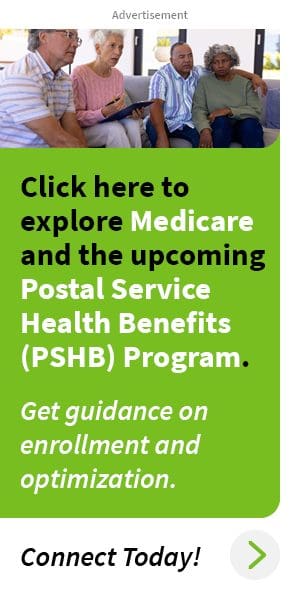Key Takeaways
-
The Postal Service Health Benefits (PSHB) program is new as of 2025, and it includes critical changes that affect active USPS employees and annuitants. You need more than just a brochure to understand how to make the right choice.
-
Official portals, interactive tools, and licensed agents offer deeper insight into eligibility, Medicare coordination, costs, and plan benefits than traditional printed guides.
Why You Need More Than the Brochure
If you’ve browsed the PSHB brochure, you already know it outlines coverage options and plan details. But brochures can only go so far. They don’t always explain how PSHB fits your personal life, your retirement path, or your Medicare decisions. They rarely address questions like:
-
What if you’re turning 65 soon?
-
What if you’re living overseas?
-
What if you have coverage through a spouse?
-
What happens if you don’t enroll in Medicare Part B?
The shift to PSHB in 2025 means that relying solely on a plan brochure could leave you unaware of costly missteps, delayed coverage, or missed enrollment windows.
Start with the Official Sources
To truly understand your PSHB options, begin with the official platforms that host verified, updated content specific to your enrollment status.
1. OPM.gov (Office of Personnel Management)
The OPM website is the foundation for understanding PSHB. It includes:
-
Official PSHB plan brochures
-
Cost-sharing details
-
Enrollment instructions
This is also where you can find the PSHB Plan Comparison Tool, which lets you filter based on your location, family size, and Medicare enrollment.
2. LiteBlue (for Active Employees)
If you’re a current USPS employee, your PSHB updates and enrollment tools are housed in your LiteBlue account. Through LiteBlue, you can:
-
Access your PSHB-specific plan list
-
Update coverage during Open Season (November to December)
-
Review your biweekly premium contributions
3. KeepingPosted.org (for Annuitants)
If you’re retired or about to retire, KeepingPosted.org is your central hub. It provides access to:
-
Enrollment timelines
-
Premium breakdowns for annuitants
-
PSHB FAQs for Medicare integration
-
Forms and instructions for qualifying life events
Don’t Skip the PSHB Plan Comparison Tool
One of the most helpful online tools for PSHB is the official comparison tool on OPM.gov. It allows you to:
-
Compare up to three plans side-by-side
-
View deductibles, copayments, and out-of-pocket maximums
-
See which plans coordinate with Medicare and offer premium reimbursement or reduced cost-sharing
This tool is more insightful than the static brochure because it tailors information based on your personal filters.
Understand Medicare Coordination the Right Way
As of 2025, certain PSHB enrollees must be enrolled in Medicare Part B to keep full benefits. The requirements differ depending on your retirement date and current Medicare enrollment status.
You need to:
-
Confirm if you’re required to enroll in Part B (especially if you retired after January 1, 2025)
-
Learn how Medicare Part B integrates with your PSHB plan
-
Understand that opting out of Medicare Part B might limit your PSHB drug and medical coverage
Some plans offer reduced deductibles, waived copays, or prescription drug savings when you enroll in Medicare. But these benefits are only available if you’re enrolled in both PSHB and Medicare Part B.
Real Help from a Licensed Agent
Not every question can be answered with a fact sheet. You may need one-on-one help when:
-
You’re unsure how retirement and Medicare affect your PSHB eligibility
-
You need clarification on costs (monthly vs. biweekly)
-
You want to avoid penalties tied to late Medicare enrollment
-
You’re choosing between Self, Self Plus One, or Family coverage
A licensed agent listed on this website can walk you through all of this without overwhelming you with unnecessary details. Agents can help explain how:
-
Premiums are split between you and the government
-
Your specific plan covers dental, vision, urgent care, or specialty visits
-
Your Medicare enrollment status impacts what drug costs you’ll face under PSHB
What to Do Before Open Season
Open Season for PSHB occurs each year from November to December. To be ready:
-
Review your plan’s ANOC (Annual Notice of Change)
-
Compare your current plan against new PSHB options
-
Reevaluate your Medicare status and enrollment timing
This preparation ensures that your new coverage starts smoothly on January 1 of the following year.
Understand the Penalties for Getting It Wrong
Choosing the wrong PSHB path can lead to:
-
Loss of prescription drug coverage if you skip Medicare Part B
-
Higher out-of-pocket costs due to missed premium reimbursement opportunities
-
Delayed or denied enrollment due to missing Open Season or qualifying event windows
There is no automatic forgiveness for missing Medicare enrollment or switching to the wrong PSHB plan outside the official windows. Be aware that once missed, some decisions can’t be corrected until the next enrollment period.
How the PSHB Prescription Drug Coverage Works
Prescription drug coverage is now tied to Medicare Part D through an Employer Group Waiver Plan (EGWP). If you’re eligible for Medicare, you’ll automatically be enrolled in this drug plan through your PSHB coverage unless you opt out.
Important details:
-
The EGWP includes a $2,000 out-of-pocket drug cap in 2025
-
Some plans waive the deductible if you’re enrolled in Medicare
-
If you decline the EGWP, you might lose all drug coverage under PSHB
Understanding this interaction requires more than a plan brochure. It means reviewing how your plan’s drug formulary works with your specific health needs and Medicare status.
Use the Right Resources Based on Your Status
Whether you’re an active employee, retiree, or turning 65 soon, your approach will differ. Here are smart choices for each status:
Active Employees
-
Use LiteBlue to manage enrollment
-
Review cost-sharing for family coverage
-
Explore high-deductible vs. standard plans if you’re eligible for an HSA
Retirees (Annuitants)
-
Visit KeepingPosted.org for premium tables and timelines
-
Coordinate PSHB with Medicare Part B and D
-
Monitor your annuitant share of premiums, which differ from employee rates
Turning 65 This Year
-
Confirm your Medicare eligibility window
-
Avoid late penalties by enrolling in Part B within 7 months of your 65th birthday
-
Explore whether your PSHB plan offers Part B reimbursement or waived copays
Why Not All Plans Are Equal
Even though all PSHB plans meet OPM standards, the coverage details vary widely. Some have:
-
Lower in-network deductibles
-
Better Medicare integration benefits
-
Wider pharmacy networks
-
More generous coinsurance for specialty care
Brochures tend to generalize. But by using digital comparison tools or speaking with a licensed agent, you can identify which plans offer the highest value for your situation.
Enrollment Timing Is Everything
Enrollment isn’t automatic in all situations. Know these key timelines:
-
Initial Medicare Enrollment: 7-month window around your 65th birthday (3 months before, the month of, and 3 months after)
-
General Enrollment Period: January 1 to March 31 annually, if you missed initial Medicare enrollment
-
Open Season for PSHB: November through early December each year
-
Special Enrollment Periods (QLEs): Available if you experience a qualifying life event, such as marriage, divorce, or relocation
Missing these deadlines can leave you without full coverage until the next cycle.
Putting It All Together: Get the Help You Actually Need
PSHB isn’t something you want to figure out after the fact. Every plan decision you make in 2025 could affect your long-term out-of-pocket costs, Medicare access, and even your prescription drug coverage. The brochure may be a start, but it’s rarely enough.
Whether you’re retiring, managing family coverage, or coordinating with Medicare, don’t wait to ask questions. Get in touch with a licensed agent listed on this website to walk through your options clearly, thoroughly, and on time.









